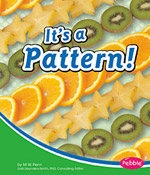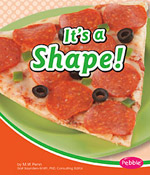A Lesson Plan for It’s a Pattern and It’s a Shape
This lesson plan combines repeating pattern and two dimensional shapes. It can be done over two or three sessions.
Books

It’s a Pattern
Pattern Recognition
NCTM Standards: Pre-K–1 Expectations
In prekindergarten through grade 1 all students should sort, classify, and order objects by size, number, and other properties; recognize, describe, and extend patterns such as sequences of sounds and shapes or simple numeric patterns and translate from one representation to another; analyze how both repeating and growing patterns are generated.

It’s a Shape
Polygons and Circles
NCTM Standards: Pre-K–1 Expectations
In prekindergarten through grade 1 all students should: recognize, name, draw, compare, and sort two-dimensional shapes; describe attributes and parts of two-dimensional shapes.
Teacher Notes
In plane geometry, a polygon is a two dimensional shape (a shape in a plane) that has straight sides and angles. Polygons have height and length but no depth.
In plane geometry, a circle is a set of all points equidistant from a given point, which is its center. The distance from the center to any point on the circle is the radius of the circle.
Pattern lies at the heart of the iterative functions of algebra. Pattern abounds in the world around us, and it is important to teach children to recognize pattern when they encounter it. In Math Matters: Understanding the Math You Teach, Chapin and Johnson state: When students explore and generalize relationships among numbers they are developing informal understanding of one of the most important topics of high school and college algebra – functions. (Chapin, Suzanne H. and Johnson, Art. 2000. Sausalito, California: Math Solutions Publications.)
Lesson Plan
The Theme of this lesson is dual: learning the names of polygons and a circle while finding and making repeating patterns.
You will need:
A copy of It’s a Pattern and a copy of It’s a Shape; at least two each of large circular disks, squares, rectangles and triangles, with each shape a different color.
For each group of children have a set of polygons and circles of uniform size cut from colored paper for them to copy; pencils, sheets of colored paper and scissors; lengths of string; glue or a hole punch to attach the string to the shapes they have made.
New words: sequence; repeat; polygon; triangle; square; rectangle; circle.
First Lesson Plan
Anticipatory Set and Objective:
Before the lesson begins, tape the large shapes to the wall in a repeating pattern that uses each shape once (e.g. square, triangle, circle, rectangle, then repeat square, etc.) Tell the children you are going to learn about patterns that repeat. Ask them if they see any repeating patterns in the classroom. When they find the pattern of repeating shapes, ask what the next color would be.
Input:
Read It’s a Pattern to the class. Discuss the pattern of sounds and ask the children to follow a repeating pattern of sound such as da, dum, da, dum…. Tell them they are going to make a repeating pattern out of different shapes.
Modeling:
Group the children into pairs or threes. Give each group a set of polygons and circles of uniform size cut from colored paper; pencils; sheets of colored paper; and scissors. Have them trace each shape four times on a different colored sheet and cut out the shapes. They can choose which color to make each shape.
Now that each group has four of each shape, ask them to form a pattern that uses just one of each shape. When they have made a pattern, have the groups switch tables and then repeat the pattern of the other group.
Guided Practice:
Have each group return to their table. Ask them to make a pattern using any combination of the shapes they have made. The pattern must repeat two times.
Check for Understanding:
Check the pattern each group has made.
Second Lesson Plan
Anticipatory Set and Objective:
Study the pattern of shapes on the wall. Talk about the properties of each shape: straight sides; pointed corners; curved; etc. Tell the class that they will learn the name of each shape.
Input:
Read It’s a Shape to the class. Ask which shapes in the book are polygons and which shape is not a polygon. Have the children find shapes in the classroom. Tell them they are going to make a mobile out of shapes.
Guided Practice:
Have each group from the previous lesson return to their table. Ask them to make a pattern of any length using any combination of the shapes they have made. The pattern they make must repeat at least two times. They can use any shape more than once in the pattern. They don’t have to use every shape in their pattern.
Check for Understanding:
Ask each student to name a shape and tell you the characteristics of that shape.
Next. discuss the pattern each group made using the names of shapes. E.g. square, square, circle, triangle, square, square, circle, triangle.
Independent Practice for Pattern and Shape:
Have the children make a mobile of their pattern, repeating the pattern twice. Some mobiles will be longer than others because some patterns will have more shapes. When the mobiles are complete, hang them and ask questions about the patterns:
Which mobile is the longest? How many shapes make up the pattern?
Which mobile is the shortest? How many shapes make up the pattern?
Can you make a pattern using only two shapes? Can you make a pattern using two shapes but using each of the two more than once? Etc.
Check again for understanding of both Pattern and Shape by using the names of each shape as individual children extend each pattern.
